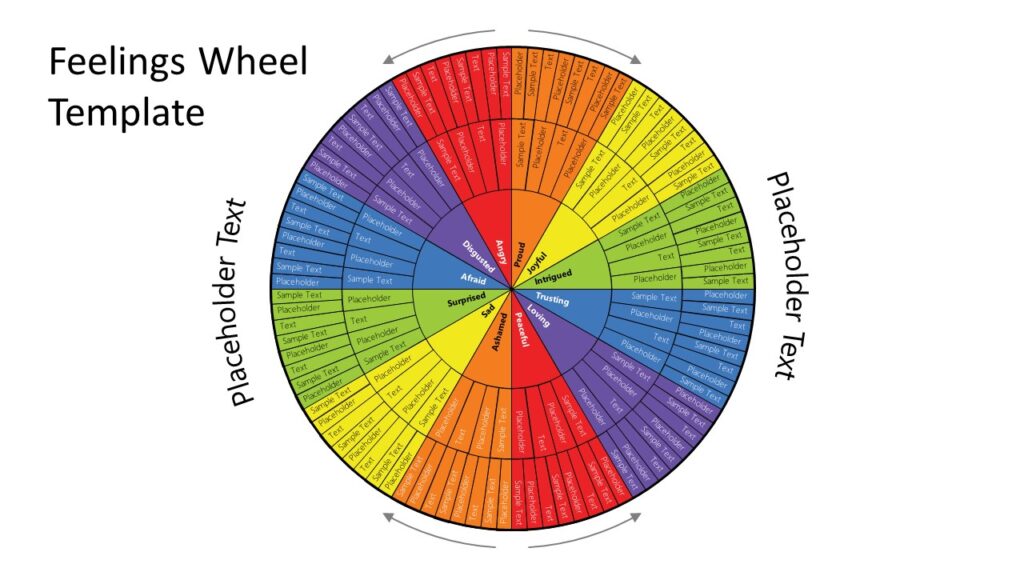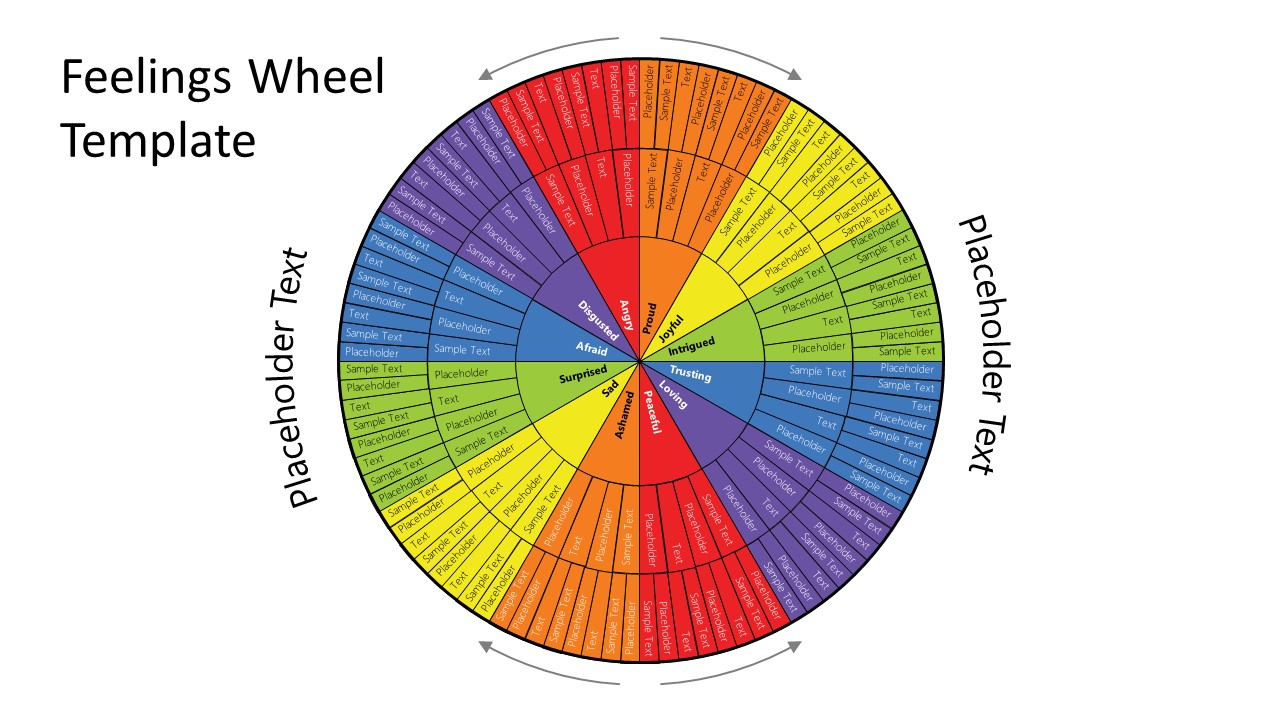
How to Use a Feelings Wheel: A Comprehensive Guide
Understanding and articulating emotions can be challenging. Many people struggle to express how they truly feel, often resorting to vague terms like “good” or “bad.” A feelings wheel is a valuable tool that can help individuals identify and name their emotions with greater precision. This comprehensive guide will explore how to use a feelings wheel effectively, its benefits, and how it can enhance emotional intelligence and communication.
What is a Feelings Wheel?
A feelings wheel, also known as an emotion wheel, is a visual tool that categorizes and displays a wide range of emotions. Typically, it consists of concentric circles, with basic emotions at the center and more nuanced feelings radiating outward. The feelings wheel provides a structured way to explore the spectrum of human emotions, helping users to pinpoint exactly what they are feeling.
The original feelings wheel was developed by Dr. Gloria Willcox in the 1980s. Since then, various iterations have been created, each designed to facilitate emotional awareness and expression. The core concept remains the same: to provide a visual aid for identifying and understanding feelings.
Why Use a Feelings Wheel?
There are numerous benefits to using a feelings wheel. Here are some key advantages:
- Increased Emotional Awareness: The feelings wheel encourages users to explore a broader range of emotions than they might typically consider. It helps to identify feelings they might not have been aware of.
- Improved Communication: By accurately naming emotions, individuals can communicate their feelings more effectively to others, leading to better understanding and stronger relationships.
- Enhanced Self-Regulation: Understanding one’s emotions is the first step toward managing them. The feelings wheel can help individuals recognize triggers and develop strategies for coping with difficult feelings.
- Reduced Emotional Overwhelm: When feelings are vague and undefined, they can feel overwhelming. Naming and categorizing emotions can make them feel more manageable.
- Greater Empathy: Understanding one’s own emotions can foster empathy for others. The feelings wheel can help individuals recognize and validate the emotions of those around them.
How to Use a Feelings Wheel: A Step-by-Step Guide
Using a feelings wheel is a straightforward process. Here’s a step-by-step guide to get you started:
Step 1: Start with the Core Emotions
Begin by focusing on the emotions at the center of the wheel. These are the primary emotions, such as happiness, sadness, anger, fear, surprise, and disgust. Ask yourself: “Which of these basic emotions am I feeling right now?”
Step 2: Explore the Outer Layers
Once you’ve identified a core emotion, move outward to the next layer of the wheel. This layer contains more specific emotions related to the core emotion. For example, if you’re feeling sad, you might explore emotions like lonely, depressed, or grief.
Step 3: Get Specific
Continue moving outward to the outermost layer of the wheel. This layer contains the most nuanced and specific emotions. For example, if you’re feeling angry, you might explore emotions like frustrated, irritated, or enraged. The more specific you can be, the better you can understand and address your feelings. This is the core of how to use a feelings wheel.
Step 4: Reflect on the Emotion
Once you’ve identified a specific emotion, take some time to reflect on it. Ask yourself: “What is causing me to feel this way? What thoughts and behaviors are associated with this emotion? What can I do to manage this emotion in a healthy way?”
Step 5: Journal Your Findings
Writing down your thoughts and feelings can be a powerful way to process emotions. Keep a journal and record your experiences with the feelings wheel. Note the emotions you identify, the situations that trigger them, and the strategies you use to manage them. Regular journaling can help you track your emotional patterns and develop greater self-awareness.
Examples of Using a Feelings Wheel in Different Situations
To illustrate how to use a feelings wheel effectively, consider the following scenarios:
Scenario 1: Workplace Stress
Imagine you’re feeling stressed at work. Instead of simply saying “I’m stressed,” you can use the feelings wheel to pinpoint the specific emotions underlying your stress. You might find that you’re feeling anxious about an upcoming deadline, overwhelmed by your workload, or frustrated with a colleague. By identifying these specific emotions, you can take targeted steps to address them, such as prioritizing tasks, delegating responsibilities, or communicating your concerns to your colleague.
Scenario 2: Relationship Conflict
During a disagreement with your partner, it’s easy to get caught up in the heat of the moment. Using a feelings wheel can help you pause and identify the emotions driving your reaction. You might realize that you’re feeling hurt because your feelings weren’t validated, or that you’re feeling defensive because you fear being criticized. By understanding your emotions, you can communicate your needs more clearly and work toward a resolution.
Scenario 3: Personal Growth
The feelings wheel isn’t just for addressing negative emotions. It can also be used to explore positive feelings and cultivate gratitude. When you’re feeling happy, take a moment to explore the nuances of your happiness. Are you feeling joyful, content, grateful, or inspired? By savoring these positive emotions, you can enhance your overall well-being and resilience.
Tips for Effective Use of a Feelings Wheel
To maximize the benefits of using a feelings wheel, consider these tips:
- Be Honest with Yourself: The feelings wheel is only effective if you’re willing to be honest about your emotions. Don’t be afraid to explore uncomfortable or difficult feelings.
- Use it Regularly: Make using the feelings wheel a regular practice. The more you use it, the more attuned you’ll become to your emotions.
- Combine it with Other Tools: The feelings wheel can be used in conjunction with other tools for emotional regulation, such as mindfulness meditation, deep breathing exercises, and cognitive behavioral therapy (CBT).
- Customize it to Your Needs: There are many different versions of the feelings wheel available. Choose one that resonates with you and customize it to reflect your unique emotional vocabulary.
- Seek Support: If you’re struggling to understand or manage your emotions, consider seeking support from a therapist or counselor. A professional can provide guidance and support as you explore your emotional landscape.
Common Mistakes to Avoid When Using a Feelings Wheel
While the feelings wheel is a valuable tool, it’s important to avoid common mistakes that can hinder its effectiveness:
- Rushing the Process: Take your time to explore the feelings wheel. Don’t rush to identify an emotion. Allow yourself to fully consider the range of possibilities.
- Overthinking: While reflection is important, avoid overthinking your emotions. Trust your intuition and choose the emotion that feels most accurate.
- Ignoring Physical Sensations: Pay attention to your body’s physical sensations. Emotions often manifest as physical symptoms, such as increased heart rate, muscle tension, or stomach upset.
- Judging Your Emotions: Avoid judging your emotions as good or bad. All emotions are valid and serve a purpose. The goal is to understand and manage your emotions, not to suppress or deny them.
- Using it in Isolation: While the feelings wheel can be a valuable tool for self-reflection, it’s important to connect with others and share your emotions. Talking to a trusted friend, family member, or therapist can provide support and perspective.
The Science Behind the Feelings Wheel
The effectiveness of the feelings wheel is supported by research in the field of psychology. Studies have shown that emotional awareness is a key component of emotional intelligence, which is associated with improved mental health, relationship satisfaction, and overall well-being. By helping individuals identify and name their emotions, the feelings wheel promotes emotional awareness and enhances emotional intelligence. Understanding how to use a feelings wheel is understanding how to improve your overall emotional IQ.
Furthermore, research has shown that labeling emotions can reduce activity in the amygdala, the part of the brain responsible for processing fear and other negative emotions. This suggests that naming emotions can help to regulate emotional responses and reduce feelings of overwhelm.
Integrating the Feelings Wheel into Daily Life
Integrating the feelings wheel into your daily life can be a transformative experience. Here are some practical ways to incorporate it into your routine:
- Morning Check-In: Start your day by checking in with your emotions. Use the feelings wheel to identify how you’re feeling and set an intention for the day.
- Midday Pause: Take a few minutes in the middle of the day to pause and reflect on your emotions. Use the feelings wheel to identify any changes in your emotional state.
- Evening Reflection: End your day by reflecting on your emotions. Use the feelings wheel to identify the emotions you experienced throughout the day and journal about your experiences.
- During Challenging Situations: When you’re facing a challenging situation, use the feelings wheel to identify the emotions driving your reaction. This can help you respond more effectively and avoid impulsive behaviors.
- In Therapy: If you’re in therapy, bring the feelings wheel to your sessions and use it as a tool for exploring your emotions with your therapist.
Conclusion
The feelings wheel is a powerful tool for enhancing emotional awareness, improving communication, and promoting self-regulation. By learning how to use a feelings wheel effectively, individuals can gain a deeper understanding of their emotions and develop strategies for managing them in healthy ways. Whether you’re seeking to improve your relationships, reduce stress, or enhance your overall well-being, the feelings wheel can be a valuable asset on your journey. Embrace this tool and unlock the power of emotional intelligence. [See also: Understanding Emotional Intelligence] [See also: Coping with Stress and Anxiety] [See also: Improving Communication Skills]

